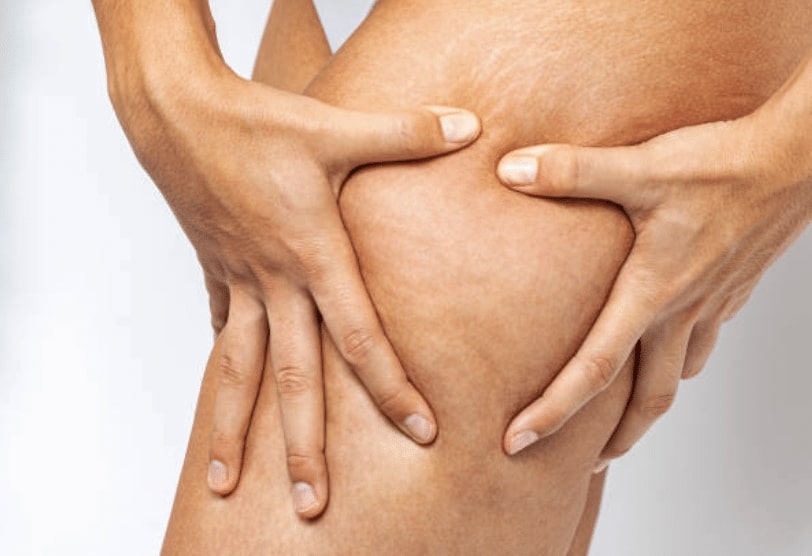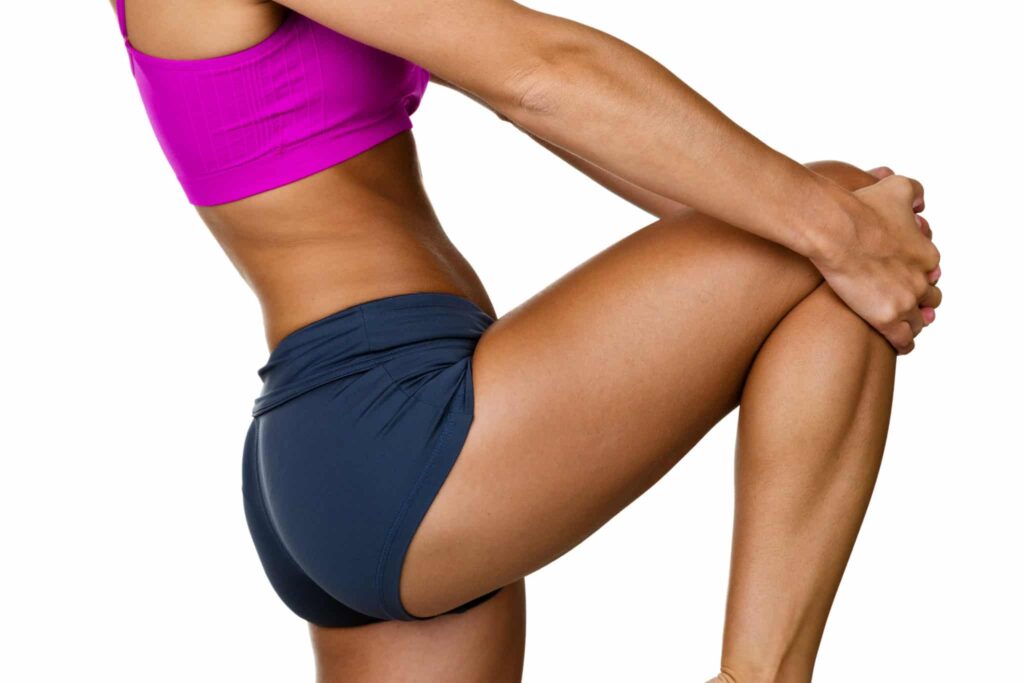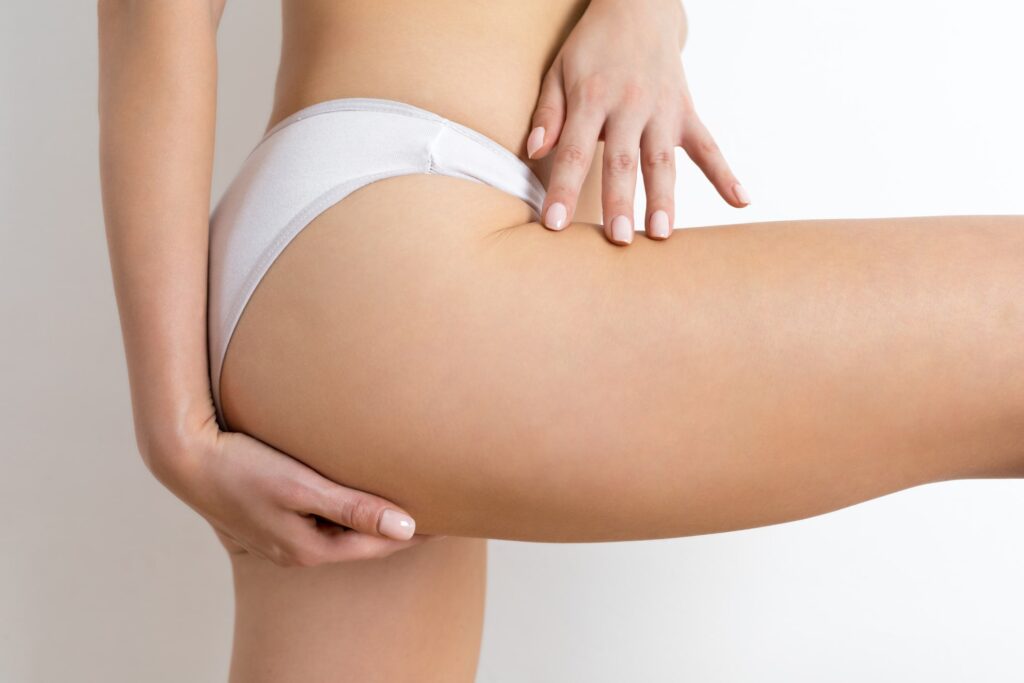
A thigh lift is performed to remove excess skin and fat from the upper legs. Candidates may suffer from loose, inelastic skin after extreme weight loss due to diet, exercise or bariatric surgery. In other cases, the outer thighs may begin to droop and sag and stubborn pockets of localized fat may develop as well. A healthy diet and exercise may not be enough to help you achieve the firm, smooth thighs you would like.
This procedure may be performed alone, or in combination with other cosmetic procedures, such as part of a body lift or with a buttock lift. When combined with other procedures, patients can achieve maximum results and enjoy a younger and more refreshed appearance overall. Your doctor will discuss your personal aesthetic goals with you in order to develop the best treatment plan for you.
A lateral thigh lift (outer thigh lift) is performed to tighten the skin around the outer thigh to form a more aesthetically pleasing frame. Your doctor will strive to produce slimmer, more contoured thighs that are proportionate to the buttocks, stomach and legs. In a lateral thigh lift, the surgical incision is made from the groin around the back of the body, and often the buttocks are lifted along with the thigh.
How common are Thigh Lifts?
Thigh lifts are not one of the more common plastic surgeries. In 2020, thigh lifts ranked in the neighborhood of hair transplants and labiaplasty with 9,275 thigh lifts performed in the U.S. This compares with hundreds of thousands of breast augmentations, eyelid surgeries, nose surgeries, and liposuction. Still, thigh lift popularity is growing. From 2000 to 2020, the numbers increased by 75 percent.

Does a Thigh Lift get rid of cellulite?
Cellulite is caused by the structure of female skin, where the connective bands that connect the skin to the muscles beneath trap fat in pockets, creating the dimpled look of cellulite.
Thigh lifts don’t do anything to address the structure of the skin, but they can remove some cellulite in some but not all cases.
To get an idea of if this procedure would help your cellulite, you can try lifting the sagging skin on your inner or outer thighs (wherever Dr. Frank J. Ferraro will focus your thigh lift). When you pull up this loose skin if your cellulite disappears by doing this, a thigh lift will likely remove the skin responsible for your cellulite. But when you do this, if your cellulite still shows, a thigh lift will not remove it.
Candidates For Thigh Lift
The thigh lift procedure is ideal for patients who are in good general health but have excess skin and tissue within the thigh area as a result of the natural aging process, pregnancy or significant weight loss. A thigh lift should not be considered an easy weight loss solution. This procedure is most effective on patients who are close to their ideal weight but unhappy with the appearance of their thighs. It is important for patients to maintain realistic expectations in order to be satisfied with the results of their thigh lift procedure.

How safe are Thigh Lifts?
These are safe procedures, and they can be very satisfying for a woman with loose skin on her thighs that seems impervious to any efforts to remove it. There are the usual risks with anesthesia and wound healing. Formation of blood clots in the legs is something to watch out for, but we get you up and moving relatively quickly and this helps minimize the chances.
How long Thigh Lift Surgery can take
These surgeries with Dr. Ferraro take about 2 hours. There can be some variation based on the method he employs. Since you’ll also spend several hours in pre-op and post-op, expect the entire process to take up most of the day. But these are outpatient procedures, so you’ll be home at the end of the day.
With thigh lifts, other possible side effects can be asymmetry of your legs and numbness or changes in skin sensation in the surgery areas. In some cases, tissue sagging will not be fully alleviated, or patient expectations may merit a secondary office procedure to fine-tune the contour of your thighs.
These are safe satisfying procedures thanks to the board-certified training and expertise of Dr. Ferraro, who has been performing these procedures in Bergen County for over 20 years.
Where are the incisions made for thigh lift surgeries?
As with all his plastic surgery procedures, Dr. Ferraro adapts his methods to the unique needs of the patient. For thigh lifts, there are a few different options. For instance, in a medial or inner thigh lift the incision may only need to be made where the thigh meets the pubic area.
This incision focuses on the upper-inner thigh. If the patient has sagging down toward the middle of the thigh, the incision may need to descend from the groin down toward the knee or toward the back of the thigh. With an outer lift, also known as a bilateral lift, he makes a V-shaped incision at the top of the leg near the hipbone, where it can be effectively hidden beneath the panty line. The incision can vary; it may wrap around the hip or buttocks area, depending on where the patient has loose skin.
Will there be noticeable scarring after my thigh lift?
As a board-certified plastic surgeon with extensive experience with both cosmetic plastic surgery and reconstructive plastic surgery, Dr. Ferraro uses his surgical expertise to hide your incisions in locations such as natural creases whenever possible. Still, there will be some visible scarring, particularly with an outer thigh lift. This will fade quite quickly after your recovery is complete. Patients are happy to have the tradeoff of some scarring in exchange for having their thighs now be slim, contoured, and devoid of loose sagging skin.
How to prepare for your Thigh Lift
These are major surgeries, so you’ll need to prepare as you would for any surgery. You’ll stop taking any blood thinning medication, aspirin, anti-inflammatories, and most herbal supplements for a few days prior to your surgery. Since you’ll be under general anesthesia, you’ll need to follow instructions on fasting timelines before your surgery.
Most of your preparation should be for your recovery. You’ll likely have to be on bed rest for at least 5 and more likely 7 days. This is due to the tissue removal and re-draping, as you cannot put any pressure on your thigh tissue. Climbing stairs, squatting, or any strenuous activity is out of the question. For the first few days, the only walking you’ll be doing is to the bathroom and back, and you’ll probably want help.

So, you’ll want to prepare your recovery nest. If you sleep upstairs, you’ll need to make a spot downstairs, as you can’t climb stairs. You’ll want lots of pillows and blankets. You’ll want all the entertainment options possible at your fingertips. You’ll be able to walk around the house after one week, but you won’t be able to drive for 3 to 4 weeks.
You get the picture. Preparation should include lining up help. You’ll need someone around to cook and take care of the kids and household stuff. This is not the time to push things with your recovery. Taking it slow and not stressing your incisions will lead to a shorter recovery, and it will make your incisions heal more cleanly and more quickly.
How is a Thigh Lift done?
Dr. Ferraro has various options for the location and type of incisions for these procedures. During your consultation, the two of you will discuss what he feels will work best for your situation. There are two overall methods, but every surgery Dr. Ferraro performs is completely unique to the patient’s situation.
This method is also called a medial thigh lift. Here, Dr. Ferraro makes the incision at the junction where the thigh meets the pubic area. This makes for a discreet incision, yet it gives Dr. Ferraro access to the necessary underlying tissues. Once the incision is made, a wedge of skin is removed, along with some (but not all) of the fat. The remaining lower edge of the incision is then pulled upward, and the incision is closed.
Also known as a bilateral thigh lift, this method has the goal of tightening the skin on the front and outside portions of the thighs. Dr. Ferraro makes a V-shaped incision at the top of the leg near the hipbone, where it can be effectively hidden beneath the panty line. The incision can vary; it may wrap around the hip or buttocks area, depending on where the patient has loose skin. Excess skin is trimmed, and the remaining skin is pulled up and attached to the other side of the incision. Outer lifts can remove more tissue than an inner lift, plus they have the added benefit of lifting the buttocks along with the thighs.
Lateral Thigh Lift Procedure
The lateral thigh lift procedure is performed under general anesthesia and requires an incision in the groin area and sometimes extending downward around the back of the thigh, depending on the results desired by the patient. This procedure requires a surgical incision of varying size depending on how much skin must be removed. The location of the incision can be adjusted based on clothing preference or overall reduction of visibility.
After the incision is made, the surgeon will tighten the tissues in the area to create a smoother and more toned contour. If there is a large amount of fat to be removed, it may be achieved through liposuction. The skin is then stretched to reposition the thighs and the incisions are closed with sutures. Compression garments are usually applied to help reduce swelling and expedite the healing process. Some patients may need to stay overnight after this procedure, while others can leave shortly after the effects of anesthesia have worn off.
Patient Testimonial
Recovery From Thigh Lift
After surgery, some patients are required to wear an elastic bandage or compression garment for the next several weeks to help support healing tissues. Patients may experience mild bruising, swelling and soreness. Discomfort is generally minimal in smaller lifts than when large amounts of skin have been removed. In either case, both pain medication and anti-inflammatory medication will be utilized as needed. The results of the procedure will be visible right away and will continue to improve as swelling and other symptoms subside.
Light labor is normally possible after less than two weeks, while most physical activity is permissible at four to six weeks post-surgery. All symptoms should be gone and scars maximally faded within six months. After recovery, patients will be able to show off their slimmer, more defined legs without any previous embarrassment. The appearance of cellulite can also be improved through this procedure. The results of a medial thigh lift can be long-lasting, as long as patients maintain an active and healthy life and do not gain significant amounts of weight. Additional surgery may be performed if this occurs.
These are not easy recoveries. Part of that is due to the way our legs are involved in virtually all our movements. Dr. Ferraro makes extensive incisions and tissue repositioning. There is a good amount of skin excision. You’ll need your prescription pain medication for at least the first few days. Compression garments help avoid movement that would be painful, plus they keep pressure on your sutured incisions. After the first 4 or 5 days, you should be able to move to over-the-counter pain medication, and the worst of your discomfort will be over.
Disclaimer: Results and patient experience may vary
When will I be able to see my results from Thigh Lift surgery?
Your results are immediate, but you won’t be able to tell due to the bruising, swelling, and the fact that they will be in compression garments. The tissue repositioning involved with a thigh lift can create swelling that tends to endure, especially at night. Some patients can take up to one year for their thighs to completely recover. Still, when the swelling has passed and your scars start to fade, you’ll love your slimmer, younger-looking contoured thighs.

How long will my results from my thigh lift last?
The changes made by Dr. Ferraro with these surgeries are permanent. The loose skin removed is gone for good. Any fat he removes will also be permanently gone. If you maintain a healthy weight, you’ll enjoy your firmer, tighter, more contoured thighs for the rest of your life.
Risks And Complications Of Thigh Lift
Although this procedure is considered safe for most patients, there are certain risks and complications associated with any type of surgical procedure. Some of these risks include scarring, infection, healing problems, blood clots and fluid accumulation. Patients can reduce these risks by choosing a skilled and experienced surgeon such to perform their procedure, and by following the doctor’s instructions before and after surgery.
Combining other Body Contouring procedures with a Thigh Lift
Thigh lifts can already combine procedures, although it’s really simply an extension. For instance, if Dr. Ferraro is combining a tummy tuck with an outer thigh lift, that can also be referred to as an extended tummy tuck, as the incision extends out around the flanks. If Dr. Ferraro completes the incision circumferentially, a buttocks lift can be a part of the contouring, as well. These procedures can also be called a lower body lift.
Liposuction is already a part of most thigh lifts, at least to some degree, but it can be added on for another location, such as the lower abdomen.
If you’d like to extend the skin tightening and contouring of your thigh lift, you should discuss this with Dr. Ferraro during your consultation. He can walk you through what would be possible and what may not be a good idea.
To schedule a consultation, click here or contact our office at (201) 664-8000
